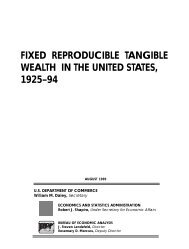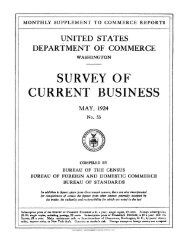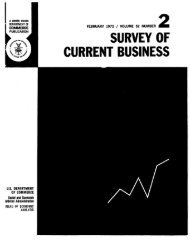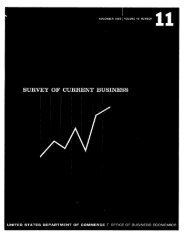Comparing NIPA Profits With S&P 500 Profits - Bureau of Economic ...
Comparing NIPA Profits With S&P 500 Profits - Bureau of Economic ...
Comparing NIPA Profits With S&P 500 Profits - Bureau of Economic ...
You also want an ePaper? Increase the reach of your titles
YUMPU automatically turns print PDFs into web optimized ePapers that Google loves.
22 March 2011<br />
BEA BRIEFING<br />
<strong>Comparing</strong> <strong>NIPA</strong> <strong>Pr<strong>of</strong>its</strong> <strong>With</strong> S&P <strong>500</strong> <strong>Pr<strong>of</strong>its</strong><br />
By Andrew W. Hodge<br />
C<br />
ORPORATE pr<strong>of</strong>its measures from the <strong>Bureau</strong> <strong>of</strong><br />
<strong>Economic</strong> Analysis national income and product<br />
accounts (<strong>NIPA</strong>s) and from Standard and Poor’s (S&P)<br />
are widely followed by economists. 1 The measures,<br />
however, differ significantly, reflecting differences in<br />
purpose, coverage, source data, definitions, and methodologies.<br />
In this article, the <strong>NIPA</strong> measures <strong>of</strong> pr<strong>of</strong>its<br />
are compared with S&P <strong>500</strong> measures <strong>of</strong> reported<br />
earnings and operating earnings. The comparison indicates<br />
that although long-term trends <strong>of</strong> <strong>NIPA</strong> pr<strong>of</strong>its<br />
measures and S&P earnings measures are broadly similar,<br />
short-term annual and quarterly growth rates can<br />
differ dramatically. For example, both S&P <strong>500</strong> earnings<br />
measures fall by larger percentages during recessions<br />
than the <strong>NIPA</strong> pr<strong>of</strong>its measures and then rise<br />
faster to converge back toward <strong>NIPA</strong> pr<strong>of</strong>its trends.<br />
<strong>NIPA</strong> pr<strong>of</strong>its measures are designed to reflect the<br />
national economic accounting concept <strong>of</strong> “income<br />
from current production” and to provide consistent<br />
coverage over time <strong>of</strong> all U.S. corporations, including<br />
private corporations and S corporations. Primarily reflecting<br />
this broader coverage, total after-tax <strong>NIPA</strong><br />
pr<strong>of</strong>its are typically about twice as high as S&P <strong>500</strong> operating<br />
earnings during expansions. In contrast, the<br />
purpose <strong>of</strong> the S&P <strong>500</strong> earnings measures is to serve<br />
as benchmarks for comparing the performance <strong>of</strong> individual<br />
companies, which are reported on a financial<br />
accounting basis that reflects “generally accepted accounting<br />
principles,” or GAAP, accounting.<br />
<strong>NIPA</strong> <strong>Pr<strong>of</strong>its</strong><br />
Corporate pr<strong>of</strong>its in national income is the income<br />
earned from current production by U.S. corporations.<br />
Because national income is defined as the income <strong>of</strong><br />
U.S. residents, its pr<strong>of</strong>its component includes income<br />
earned abroad by U.S. corporations and excludes income<br />
earned in the United States by foreign corporations<br />
or their subsidiaries. Income consists <strong>of</strong> receipts<br />
from current production less associated expenses.<br />
<strong>NIPA</strong> receipts exclude income in the form <strong>of</strong> dividends<br />
and capital gains. <strong>NIPA</strong> expenses exclude bad debts,<br />
1. Information about the S&P <strong>500</strong> index is available at<br />
www2.standardandpoors.com/spf/pdf/index/SP_<strong>500</strong>_Factsheet.pdf.<br />
depletion, and capital losses. <strong>NIPA</strong> pr<strong>of</strong>its from current<br />
production—pr<strong>of</strong>its before tax with inventory<br />
valuation and capital consumption adjustments—are<br />
based on valuations <strong>of</strong> withdrawals from inventories<br />
and depreciation <strong>of</strong> fixed assets at current cost that use<br />
consistent depreciation pr<strong>of</strong>iles based on used asset<br />
prices.<br />
Source data<br />
Most businesses report pr<strong>of</strong>its information on a financial-accounting<br />
basis and on a tax-accounting basis.<br />
While both financial accounting and tax accounting<br />
calculate pr<strong>of</strong>its as the difference between receipts and<br />
expenses, they differ in the definitions <strong>of</strong> some receipts<br />
and expenses and in the timing <strong>of</strong> when some receipts<br />
and expenses are recorded. Neither tax accounting<br />
measures nor financial accounting measures are entirely<br />
suitable for implementing the <strong>NIPA</strong> concept <strong>of</strong><br />
corporate pr<strong>of</strong>its. Consequently, the procedure for estimating<br />
<strong>NIPA</strong> corporate pr<strong>of</strong>its mainly consists <strong>of</strong> adjusting,<br />
supplementing, and integrating financialbased<br />
and tax-based source data.<br />
The tax accounting measures published annually by<br />
the Internal Revenue Service (IRS) in Statistics <strong>of</strong> Income<br />
(SOI): Corporation Income Tax Returns are the<br />
primary source data for the annual <strong>NIPA</strong> estimates <strong>of</strong><br />
corporate pr<strong>of</strong>its. 2 This comprehensive IRS reporting<br />
<strong>of</strong> federal corporate income tax returns is only available<br />
annually and with a 2-year lag. Although financial<br />
data are less comprehensive than tax data, they are prepared<br />
quarterly, and they are available sooner. As a result,<br />
data from financial accounting measures,<br />
including financial data from the Census <strong>Bureau</strong>, publicly<br />
available financial accounting pr<strong>of</strong>its data, and<br />
other source data are used to interpolate and extrapolate<br />
the tax-return-based <strong>NIPA</strong> pr<strong>of</strong>its. 3<br />
The key <strong>NIPA</strong> data source for the most recent year<br />
and for the quarterly estimates for manufacturing,<br />
mining, and wholesale and retail trade sector pr<strong>of</strong>its is<br />
the Census <strong>Bureau</strong>’s Quarterly Financial Report. 4 This<br />
2. For more information, go to www.irs.gov/pub/irs-soi/07coccr.pdf.<br />
3. These procedures are described in www.bea.gov/scb/pdf/NATIONAL/<br />
<strong>NIPA</strong>/Methpap/methpap2.pdf.<br />
4. For more information, go to www.census.gov/csd/qfr/view/qfr_mg.pdf.
March 2011<br />
SURVEY OF CURRENT BUSINESS<br />
23<br />
report provides quarterly source data for operating<br />
pr<strong>of</strong>its for about 9,000 companies. Nearly all <strong>of</strong> the<br />
companies in the surveyed sectors that have domestic<br />
assets <strong>of</strong> over $250 million are included. Smaller corporations,<br />
including private corporations and S corporations,<br />
are sampled.<br />
Financial reports filed with regulatory authorities<br />
provide pr<strong>of</strong>it indicators for commercial banks, savings<br />
and loans, and property and casualty insurers.<br />
The largest <strong>of</strong> these is the Federal Deposit Insurance<br />
Corporation report on insured institutions in the<br />
Quarterly Banking Pr<strong>of</strong>ile. 5 The remaining sectors <strong>of</strong><br />
the economy are estimated with matched sample panels<br />
<strong>of</strong> adjusted financial accounting earnings compiled<br />
from publicly available sources.<br />
In order to estimate <strong>NIPA</strong> corporate pr<strong>of</strong>its, the SOI<br />
tabulations <strong>of</strong> “total receipts less total deductions” are<br />
adjusted to conform to <strong>NIPA</strong> concepts. 6 In particular,<br />
the adjustments to exclude capital gains from <strong>NIPA</strong> receipts<br />
and capital losses and bad debts from <strong>NIPA</strong> expenses<br />
result in significant differences between the<br />
<strong>NIPA</strong> measures <strong>of</strong> corporate pr<strong>of</strong>its and both the financial<br />
accounting and the tax accounting measures.<br />
Capital gains and losses are excluded from the <strong>NIPA</strong><br />
pr<strong>of</strong>its measures because they result from the revaluation<br />
<strong>of</strong> existing assets rather than from current production.<br />
Similarly, bad debts are not deducted as<br />
expenses, because they are not costs <strong>of</strong> current produc<br />
5. For more information, go to www2.fdic.gov/qbp/<br />
qbpSelect.asp?menuItem=QBP.<br />
6. See <strong>NIPA</strong> table 7.16, “Relation <strong>of</strong> Corporate <strong>Pr<strong>of</strong>its</strong>, Taxes, and Dividends<br />
in the National Income and Product Accounts to Corresponding<br />
Measures as Published by the Internal Revenue Service.”<br />
tion. <strong>NIPA</strong> table 7.16 shows the relation <strong>of</strong> corporate<br />
pr<strong>of</strong>its, taxes, and dividends in the <strong>NIPA</strong>s to corresponding<br />
measures published by the IRS. The two<br />
largest adjustments are the misreporting adjustment<br />
and the adjustments for capital gains and losses on the<br />
sale <strong>of</strong> property.<br />
National and domestic pr<strong>of</strong>its<br />
The <strong>NIPA</strong>s include tabulations for both national pr<strong>of</strong>its<br />
and domestic pr<strong>of</strong>its. <strong>NIPA</strong> national pr<strong>of</strong>its are<br />
closer in concept to the GAAP and S&P <strong>500</strong>, because<br />
like GAAP, they are the global pr<strong>of</strong>its <strong>of</strong> U.S.-headquartered<br />
companies only. In contrast, domestic pr<strong>of</strong>its<br />
are pr<strong>of</strong>its earned from U.S. operations regardless <strong>of</strong><br />
where the company is headquartered. National pr<strong>of</strong>its<br />
are part <strong>of</strong> national income (shown in <strong>NIPA</strong> table 1.12)<br />
in the <strong>NIPA</strong>s, and domestic pr<strong>of</strong>its are part <strong>of</strong> gross domestic<br />
income (shown in <strong>NIPA</strong> table 1.10).<br />
National pr<strong>of</strong>its have been growing more rapidly<br />
than domestic pr<strong>of</strong>its because <strong>of</strong> rapid foreign earnings<br />
growth, which has grown elevenfold since 1980. The<br />
share <strong>of</strong> national corporate pr<strong>of</strong>its accounted for by<br />
foreign pr<strong>of</strong>its (receipts from the rest <strong>of</strong> the world) has<br />
trended upward for the last 60 years, peaking at 45.3<br />
percent in 2008 (chart 1).<br />
To analyze income earned from domestic production<br />
activities, a measure <strong>of</strong> domestic corporate pr<strong>of</strong>its<br />
and other income earned in the United States is<br />
needed. Domestic pr<strong>of</strong>its are part <strong>of</strong> gross domestic income,<br />
which is conceptually equivalent to gross domestic<br />
product, though measurement differences<br />
generally yield a small statistical discrepancy between<br />
the two. To prepare estimates <strong>of</strong> domestic pr<strong>of</strong>its,<br />
Chart 1. Foreign <strong>Pr<strong>of</strong>its</strong>’ Share <strong>of</strong> <strong>NIPA</strong> National <strong>Pr<strong>of</strong>its</strong><br />
Percent<br />
50<br />
45<br />
40<br />
35<br />
30<br />
25<br />
20<br />
15<br />
10<br />
5<br />
0<br />
1950 1955 1960 1965 1970 1975 1980 1985 1990 1995 2000 2005 2009<br />
U.S. <strong>Bureau</strong> <strong>of</strong> <strong>Economic</strong> Analysis
24 <strong>Comparing</strong> <strong>NIPA</strong> <strong>Pr<strong>of</strong>its</strong> <strong>With</strong> S&P <strong>500</strong> <strong>Pr<strong>of</strong>its</strong> March 2011<br />
adjustments remove foreign earnings <strong>of</strong> U.S.<br />
corporations and add earnings <strong>of</strong> foreign companies in<br />
the United States.<br />
Before- and after-tax pr<strong>of</strong>its<br />
The <strong>NIPA</strong>s present a variety <strong>of</strong> pr<strong>of</strong>its measures, including<br />
before-tax and after-tax pr<strong>of</strong>its. Table 1 shows<br />
the major <strong>NIPA</strong> pr<strong>of</strong>its concepts, their relations to each<br />
other, and the adjustments needed. National corporate<br />
pr<strong>of</strong>its before tax incorporates adjustments to IRS “total<br />
receipts less total deductions” shown in <strong>NIPA</strong> table<br />
7.16.<br />
<strong>Pr<strong>of</strong>its</strong> before tax reflect the charges used in tax accounting<br />
for inventory withdrawals and depreciation.<br />
The inventory valuation adjustment (IVA) and the<br />
capital consumption adjustment (CCAdj) are used to<br />
adjust before-tax pr<strong>of</strong>its to <strong>NIPA</strong> asset valuation concepts.<br />
The IVA adjusts inventories to a current-cost basis,<br />
which is similar to valuation <strong>of</strong> inventory<br />
withdrawals on a last-in/first-out basis. The CCAdj adjusts<br />
tax-reported depreciation to the <strong>NIPA</strong> concept <strong>of</strong><br />
economic depreciation (or “consumption <strong>of</strong> fixed capital”),<br />
which values fixed assets at current cost and uses<br />
consistent depreciation pr<strong>of</strong>iles based on used asset<br />
prices. Recent depreciation adjustments, which reflect<br />
the difference between tax-based depreciation and the<br />
<strong>NIPA</strong> estimates <strong>of</strong> economic depreciation, have been<br />
large, reaching a value <strong>of</strong> –$180.5 billion in 2007. Bonus<br />
depreciation in the recent tax laws has raised tax<br />
accounting depreciation, most recently to 100 percent<br />
expensing in the same year, to reduce corporate pr<strong>of</strong>its<br />
taxes.<br />
National after-tax pr<strong>of</strong>its without IVA and CCAdj<br />
are conceptually closest to S&P <strong>500</strong> pr<strong>of</strong>its, since S&P<br />
<strong>500</strong> pr<strong>of</strong>its measure the after-tax worldwide earnings<br />
<strong>of</strong> U.S. corporations. They also appear to have trended<br />
similarly with S&P <strong>500</strong> operating pr<strong>of</strong>its, as discussed<br />
in the final section.<br />
S&P <strong>500</strong> <strong>Pr<strong>of</strong>its</strong><br />
The S&P <strong>500</strong> measures <strong>of</strong> reported earnings, operating<br />
earnings, and earnings per share reflect the aggregate<br />
earnings <strong>of</strong> the <strong>500</strong> corporations that compose the<br />
stock index, and they are measured on a financial-accounting<br />
basis. Reported earnings are based on the after-tax<br />
earnings that are publicly reported by<br />
corporations, which include operating and nonoperating<br />
earnings.<br />
Table 1. <strong>NIPA</strong> <strong>Pr<strong>of</strong>its</strong>, Taxes on Corporate Income, and <strong>Pr<strong>of</strong>its</strong> After Tax<br />
[Billions <strong>of</strong> dollars]<br />
Corporate pr<strong>of</strong>its before tax<br />
Corporate pr<strong>of</strong>its after tax<br />
Year<br />
Corporate<br />
pr<strong>of</strong>its<br />
with IVA<br />
and CCAdj<br />
Corporate<br />
pr<strong>of</strong>its<br />
before tax<br />
National Domestic industries Rest <strong>of</strong> the world<br />
Taxes on<br />
National Domestic industries<br />
corporate<br />
income<br />
IVA<br />
CCAdj<br />
Corporate<br />
pr<strong>of</strong>its<br />
with IVA<br />
and CCAdj<br />
<strong>Pr<strong>of</strong>its</strong><br />
before tax<br />
Total<br />
Receipts<br />
from the<br />
rest <strong>of</strong> the<br />
world<br />
Less:<br />
Payments<br />
to the rest<br />
<strong>of</strong> the world<br />
<strong>Pr<strong>of</strong>its</strong><br />
after tax<br />
with IVA<br />
and CCAdj<br />
<strong>Pr<strong>of</strong>its</strong><br />
after tax<br />
<strong>Pr<strong>of</strong>its</strong><br />
after tax<br />
with IVA<br />
and CCAdj<br />
<strong>Pr<strong>of</strong>its</strong><br />
after tax<br />
1 2 3 4 5 6 7 8 9 10<br />
11<br />
12<br />
13<br />
14<br />
1980 .......................................... 201.4 253.5 –42.1 –10.0 166.0 218.1 35.5 43.8 8.4 87.2 114.2 166.4 78.8 130.9<br />
1981 .......................................... 223.3 243.7 –24.6 4.2 193.6 214.1 29.7 38.1 8.4 84.3 138.9 159.4 109.3 129.7<br />
1982 .......................................... 205.7 198.6 –7.5 14.6 173.1 166.0 32.6 36.7 4.1 66.5 139.2 132.1 106.6 99.5<br />
1983 .......................................... 259.8 234.0 –7.4 33.3 224.8 198.9 35.1 41.1 6.0 80.6 179.2 153.4 144.1 118.3<br />
1984 .......................................... 318.6 268.6 –4.0 54.0 282.0 232.0 36.6 46.1 9.5 97.5 221.1 171.1 184.5 134.5<br />
1985 .......................................... 332.5 257.5 0.0 75.1 294.4 219.4 38.1 46.8 8.7 99.4 233.1 158.1 195.0 120.0<br />
1986 .......................................... 314.1 246.0 7.1 61.1 274.7 206.5 39.5 48.7 9.2 109.7 204.5 136.3 165.0 96.8<br />
1987 .......................................... 367.8 323.1 –16.2 61.0 319.8 275.1 48.0 58.9 10.9 130.4 237.4 192.7 189.4 144.6<br />
1988 .......................................... 426.6 389.9 –22.2 58.9 369.6 332.9 57.0 71.6 14.6 141.6 285.0 248.3 228.0 191.3<br />
1989 .......................................... 425.6 390.5 –16.3 51.5 358.4 323.3 67.1 75.5 8.4 146.1 279.5 244.4 212.4 177.3<br />
1990 .......................................... 434.4 411.7 –12.9 35.7 358.4 335.6 76.1 80.9 4.8 145.4 289.0 266.3 212.9 190.2<br />
1991 .......................................... 457.3 425.4 4.9 27.0 380.8 348.9 76.5 75.5 –1.0 138.6 318.7 286.8 242.2 210.3<br />
1992 .......................................... 496.2 474.4 –2.8 24.6 423.1 401.3 73.1 78.3 5.2 148.7 347.5 325.7 274.4 252.6<br />
1993 .......................................... 543.7 519.0 –4.0 28.7 466.8 442.1 76.9 88.9 12.0 171.0 372.7 348.0 295.7 271.1<br />
1994 .......................................... 628.2 599.0 –12.4 41.6 550.3 521.1 78.0 104.5 26.6 193.1 435.1 405.9 357.1 327.9<br />
1995 .......................................... 716.2 684.3 –18.3 50.2 623.2 591.3 92.9 127.4 34.4 217.8 498.3 466.5 405.4 373.5<br />
1996 .......................................... 801.5 740.7 3.1 57.7 699.5 638.8 102.0 139.4 37.4 231.5 570.0 509.3 468.1 407.3<br />
1997 .......................................... 884.8 801.8 14.1 69.0 777.3 694.2 107.6 155.5 47.9 245.4 639.4 556.3 531.9 448.8<br />
1998 .......................................... 812.4 722.9 15.7 73.8 709.7 620.1 102.8 146.8 44.0 248.4 564.1 474.5 461.3 371.8<br />
1999 .......................................... 856.3 780.5 –4.0 79.7 734.8 659.0 121.5 176.8 55.3 258.8 597.5 521.7 476.0 400.2<br />
2000 .......................................... 819.2 772.5 –16.8 63.6 673.6 626.8 145.6 202.5 56.9 265.1 554.1 507.4 408.5 361.8<br />
2001 .......................................... 784.2 712.7 8.0 63.4 614.5 543.0 169.7 182.6 12.9 203.3 580.9 509.4 411.2 339.7<br />
2002 .......................................... 872.2 765.3 –2.6 109.4 714.3 607.5 157.9 204.4 46.5 192.3 679.9 573.0 522.0 415.1<br />
2003 .......................................... 977.8 903.5 –11.3 85.6 812.0 737.7 165.8 249.2 83.4 243.8 734.0 659.7 568.3 494.0<br />
2004 .......................................... 1,246.9 1,229.4 –34.3 51.8 1,041.9 1,024.4 205.0 328.2 123.1 306.1 940.8 923.3 735.8 718.3<br />
2005 .......................................... 1,456.1 1,640.2 –30.7 –153.4 1,216.6 1,400.7 239.4 384.1 144.6 412.4 1,043.7 1,227.8 804.3 988.3<br />
2006 .......................................... 1,608.3 1,822.7 –38.0 –176.4 1,351.5 1,565.9 256.8 434.4 177.6 473.3 1,135.0 1,349.5 878.2 1,092.6<br />
2007 .......................................... 1,510.6 1,738.4 –47.2 –180.5 1,159.8 1,387.5 350.9 510.6 159.7 445.5 1,065.2 1,292.9 714.3 942.0<br />
2008 .......................................... 1,262.8 1,333.2 –44.1 –26.3 851.5 921.9 411.3 571.8 160.5 308.4 954.4 1,024.8 543.1 613.6<br />
2009 .......................................... 1,258.0 1,316.7 11.9 –70.6 905.7 964.4 352.3 480.6 128.3 254.9 1,003.1 1,061.8 650.8 709.5<br />
<strong>NIPA</strong> National income and product accounts<br />
IVA Inventory valuation adjustment<br />
CCAdj Capital consumption adjustment
March 2011 SURVEY OF CURRENT BUSINESS 25<br />
The S&P <strong>500</strong> stock index is intended to gauge<br />
changes in the total stock market value <strong>of</strong> the <strong>500</strong> leading<br />
corporations chosen by S&P. The inclusion <strong>of</strong> a<br />
corporation in the index is based on its market value,<br />
capitalization, trading activity, and industry group<br />
representation. As a market-based index, the S&P <strong>500</strong><br />
company list is continuously changing. Companies<br />
grow or shrink, undergo mergers and acquisitions,<br />
bankruptcy, or restructuring. They may no longer satisfy<br />
trading volume or stock price minimums. Because<br />
the composition <strong>of</strong> companies in the S&P <strong>500</strong> changes<br />
regularly, the S&P <strong>500</strong> earnings measures reflect a<br />
shifting market basket <strong>of</strong> corporations, and the series<br />
for reported earnings and operating earnings are discontinuous<br />
over time. Their growth rates partly reflect<br />
changes in the composition <strong>of</strong> the index.<br />
The most commonly used measure <strong>of</strong> S&P <strong>500</strong> total<br />
pr<strong>of</strong>its includes nonoperating pr<strong>of</strong>its and losses. The<br />
largest nonoperating expenses are pension valuation<br />
and pension interest adjustments, including adjustments<br />
for securities in defined benefit pension programs,<br />
and capital losses, including writedowns and<br />
goodwill impairments. There are no agreed upon generally<br />
accepted accounting principles (GAAP) for<br />
which “nonoperating” items should be excluded, but<br />
S&P applies a consistent methodology to produce an<br />
index <strong>of</strong> operating earnings. These nonoperating losses<br />
tend to become larger during recessions, as shown in<br />
chart 2, and further depress S&P total earnings.<br />
S&P quarterly estimates are rarely restated. Early<br />
estimates <strong>of</strong> taxes due, for example, remain the same<br />
even when actual taxes owed are revised.<br />
Differences Between Annual <strong>NIPA</strong> and<br />
S&P <strong>500</strong> <strong>Pr<strong>of</strong>its</strong><br />
The main differences between annual <strong>NIPA</strong> pr<strong>of</strong>its and<br />
S&P <strong>500</strong> pr<strong>of</strong>its are differences in coverage, industry<br />
representation, and accounting principles.<br />
Coverage<br />
<strong>NIPA</strong> pr<strong>of</strong>its include the pr<strong>of</strong>its <strong>of</strong> all U.S.-headquartered<br />
corporations. S&P <strong>500</strong> pr<strong>of</strong>its exclude unconsolidated<br />
subsidiaries, all other public corporations, all<br />
private C corporations, and all S corporations,<br />
In 2007, the latest year for which IRS data are available,<br />
5.9 million corporate tax returns were filed. Because<br />
the earnings <strong>of</strong> small and midsized corporations<br />
do not necessarily move in line with the earnings <strong>of</strong><br />
large corporations, changes in <strong>NIPA</strong> pr<strong>of</strong>its may differ<br />
from changes in S&P <strong>500</strong> earnings. The <strong>NIPA</strong> pr<strong>of</strong>its<br />
measures include, for example, all the corporations,<br />
even those that show persistent losses, but the S&P <strong>500</strong><br />
measures are limited to the largest, and generally more<br />
pr<strong>of</strong>itable, corporations. All these coverage differences<br />
will tend to produce varying earnings growth results.<br />
Industry representation<br />
The S&P <strong>500</strong> index is limited to publicly traded corporations,<br />
so certain sectors <strong>of</strong> the economy—such as<br />
construction, legal services, and medical services—<br />
may be under-represented because fewer corporations<br />
in these sectors meet the criteria for inclusion in the<br />
S&P <strong>500</strong> index.<br />
Thus, the industry composition <strong>of</strong> the S&P <strong>500</strong><br />
earnings does not reflect the industry composition <strong>of</strong><br />
Chart 2. <strong>NIPA</strong> Corporate <strong>Pr<strong>of</strong>its</strong> and S&P Corporate <strong>Pr<strong>of</strong>its</strong><br />
1990=100<br />
600<br />
400<br />
200<br />
S&P <strong>500</strong> operating index<br />
S&P <strong>500</strong> reported index<br />
<strong>NIPA</strong> national after-tax index<br />
0<br />
–200<br />
–400<br />
–600<br />
1990 1991 1992 1993 1994 1995 1996 1997 1998 1999 2000 2001 2002 2003 2004 2005 2006 2007 2008 2009 2010<br />
NOTE. The shaded areas mark the beginning and end <strong>of</strong> recessions as determined by the Business Cycle Dating Committee<br />
<strong>of</strong> the National <strong>Bureau</strong> <strong>of</strong> <strong>Economic</strong> Research.<br />
U.S. <strong>Bureau</strong> <strong>of</strong> <strong>Economic</strong> Analysis
26 <strong>Comparing</strong> <strong>NIPA</strong> <strong>Pr<strong>of</strong>its</strong> <strong>With</strong> S&P <strong>500</strong> <strong>Pr<strong>of</strong>its</strong> March 2011<br />
the overall economy. Specifically, energy, manufacturing,<br />
information technology, and financial corporations<br />
are disproportionately represented in the S&P<br />
<strong>500</strong> and in some recent years have accounted for more<br />
than 80 percent <strong>of</strong> S&P <strong>500</strong> operating earnings.<br />
Accounting principles<br />
Accounting principles affect the definition <strong>of</strong> some receipts<br />
and expenses and their timing and thus have an<br />
impact on corporate pr<strong>of</strong>its measures.<br />
● The appreciation <strong>of</strong> securities in corporate-sponsored<br />
defined benefit pension plans can result in<br />
increased earnings under financial accounting but<br />
not in SOI or <strong>NIPA</strong> measures.<br />
● The respective treatments <strong>of</strong> employee stock options<br />
differ significantly. <strong>NIPA</strong> accounting and tax<br />
accounting have always treated employee stock<br />
options as an expense only when (and if) options<br />
are exercised. It is an operating expense and therefore<br />
always a cost deduction in the <strong>NIPA</strong> pr<strong>of</strong>its calculation.<br />
However, GAAP accounting now expenses<br />
options at grant or on a schedule beginning at<br />
grant. The valuation <strong>of</strong> the options is based on a<br />
formula that is in turn based on the right to eventual<br />
exercise, and considerable discretion is allowed.<br />
Until 2006, GAAP option expense reporting was<br />
completely at a company’s discretion and reported<br />
as a nonoperating expense or, <strong>of</strong>ten, not reported at<br />
all. Since 2006, options grant expense was mandated<br />
by GAAP. It was included in S&P reporting<br />
starting in 2006 as an operating pr<strong>of</strong>its deduction. 7<br />
● Expenditures associated with plant closings and<br />
7. Carol E. Moylan, “Employee Stock Options and the National <strong>Economic</strong><br />
Accounts,” SURVEY OF CURRENT BUSINESS 88 (February 2008): 7–13.<br />
company reorganizations are recorded as an<br />
expense under financial accounting when companies<br />
establish reserves for their estimated future<br />
costs. In tax accounting, these expenditures are<br />
recorded only when they are actually made. Such<br />
differences can result in substantial short-term<br />
divergences between the S&P and <strong>NIPA</strong> measures <strong>of</strong><br />
pr<strong>of</strong>its.<br />
● The adjustment <strong>of</strong> S&P earnings to an operating<br />
earnings concept depends on interpretations <strong>of</strong><br />
what constitutes special or extraordinary items and<br />
the degree to which corporations disclose or quantify<br />
the amounts.<br />
● The corporate taxes deducted in preparing S&P <strong>500</strong><br />
pr<strong>of</strong>its are early estimates <strong>of</strong> taxes that are based on<br />
future taxes due. They are not revised. Early <strong>NIPA</strong><br />
tax accrual estimates are revised when payments<br />
and SOI data are available. S&P <strong>500</strong> companies<br />
report pre-tax earnings, but they tend to be less<br />
prominently featured.<br />
It is therefore misleading to directly compare the<br />
growth rates <strong>of</strong> the <strong>NIPA</strong> measures <strong>of</strong> corporate pr<strong>of</strong>its<br />
with those <strong>of</strong> the S&P <strong>500</strong> measures or others like<br />
them. However, comparisons are meaningful if adjustments<br />
are made for the differences in coverage, industry<br />
composition, and definitions.<br />
The adjusted <strong>NIPA</strong> after-tax pr<strong>of</strong>its estimates, which<br />
include capital gains and losses and bad debt expenses,<br />
provide one conceptual bridge to understand the differences<br />
between <strong>NIPA</strong> growth rates and SOI growth<br />
rates (table 2). The differences between the growth<br />
rates <strong>of</strong> S&P reported earnings per share and those <strong>of</strong><br />
S&P reported earnings and the differences between the<br />
growth rates <strong>of</strong> S&P operating earnings per share and<br />
those <strong>of</strong> S&P operating earnings reflect the impact <strong>of</strong><br />
Table 2. Comparison <strong>of</strong> Selected Measures <strong>of</strong> <strong>Pr<strong>of</strong>its</strong><br />
Line 2000 2001 2002 2003 2004 2005 2006 2007 2008 2009<br />
Billions <strong>of</strong> dollars:<br />
<strong>NIPA</strong> national pr<strong>of</strong>its after tax 1 ........................................................................ 1 507.4 509.4 573.0 659.7 923.3 1,227.8 1,349.5 1,292.9 1,024.8 1,061.8<br />
Less: Bad debt expense................................................................................... 2 107.7 142.2 168.0 151.1 139.7 119.0 105.9 130.0 ................. .................<br />
Plus: Capital gains, net <strong>of</strong> losses ..................................................................... 3 286.3 156.6 96.4 123.3 170.8 246.1 281.5 324.5 ................. .................<br />
Equals: Adjusted <strong>NIPA</strong> national pr<strong>of</strong>its after tax ............................................... 4 686.0 523.8 501.4 631.9 954.4 1,354.9 1,525.1 1,487.4 ................. .................<br />
Percent change from preceding year:<br />
S&P <strong>500</strong> reported earnings..............................................................................<br />
Earnings per share....................................................................................... 5 3.8 –50.6 11.7 76.7 20.1 19.4 16.6 –18.8 –77.5 242.5<br />
Earnings....................................................................................................... 6 9.0 –48.5 13.8 77.7 21.0 16.4 15.7 –20.0 –77.8 244.8<br />
S&P <strong>500</strong> operating earnings ............................................................................<br />
Earnings per share....................................................................................... 7 8.6 –30.8 18.5 18.8 23.8 13.0 14.7 –5.9 –40.0 14.8<br />
Earnings....................................................................................................... 8 14.2 –27.9 20.6 19.4 24.7 10.2 13.8 –7.4 –41.0 16.0<br />
SOI total receipts less deductions.................................................................... 9 –1.2 –35.5 –6.7 36.1 43.6 75.9 0.4 –5.9 ................. .................<br />
Adjusted <strong>NIPA</strong> national pr<strong>of</strong>its after tax (based on line 4) ................................ 10 –0.7 –23.6 –4.3 26.0 51.0 42.0 12.6 –2.5 ................. .................<br />
<strong>NIPA</strong> national pr<strong>of</strong>its after tax (based on line 1) ............................................... 11 –2.7 0.4 12.5 15.1 40.0 33.0 9.9 –4.2 –20.7 3.6<br />
1. <strong>With</strong>out inventory valuation adjustment and capital consumption adjustment<br />
<strong>NIPA</strong> National income and product accounts<br />
S&P Standard & Poor’s<br />
SOI Statistics <strong>of</strong> Income
March 2011<br />
SURVEY OF CURRENT BUSINESS<br />
27<br />
corporate turnover in the S&P <strong>500</strong>, and the differences<br />
between the growth rates <strong>of</strong> S&P operating earnings<br />
and those <strong>of</strong> SOI before-tax receipts less deductions reflect<br />
the differences in coverage, industry representation,<br />
and accounting principles between the after-tax<br />
S&P <strong>500</strong> operating earnings and the pretax SOI tax return<br />
tabulations. The differences between growth rates<br />
<strong>of</strong> SOI before-tax receipts less deductions and those <strong>of</strong><br />
<strong>NIPA</strong> national pr<strong>of</strong>its after tax reflect the adjustments<br />
that are made to the SOI data to prepare <strong>NIPA</strong> pr<strong>of</strong>its<br />
estimates.<br />
The growth rates <strong>of</strong> the various measures <strong>of</strong> pr<strong>of</strong>its<br />
are similar in some years and differ considerably in<br />
others. For example, <strong>NIPA</strong> after-tax pr<strong>of</strong>its decreased<br />
20.7 percent in 2008, while S&P <strong>500</strong> operating earnings<br />
decreased 41.0 percent and S&P <strong>500</strong> reported<br />
earnings decreased 77.8 percent.<br />
Quarterly <strong>NIPA</strong> and S&P <strong>500</strong> <strong>Pr<strong>of</strong>its</strong><br />
Most <strong>of</strong> the differences noted above for the annual estimates<br />
also apply to the quarterly estimates. The impacts<br />
<strong>of</strong> the differences are more concentrated in<br />
quarterly pr<strong>of</strong>its, resulting in even larger gaps between<br />
<strong>NIPA</strong> and S&P quarterly growth rates. The quarterly<br />
differences may also reflect the fact that <strong>NIPA</strong> corporate<br />
pr<strong>of</strong>its measures are seasonally adjusted, while the<br />
S&P <strong>500</strong> measures are not.<br />
However, the long-term trend is broadly similar, especially<br />
between S&P operating earnings and <strong>NIPA</strong> national<br />
pr<strong>of</strong>its after tax without IVA and CCAdj.<br />
The quarterly S&P operating and reported earnings<br />
and quarterly <strong>NIPA</strong> pr<strong>of</strong>its in chart 2 are expressed as<br />
indexes to facilitate comparisons between S&P earnings<br />
and the generally much higher <strong>NIPA</strong> pr<strong>of</strong>its. The<br />
<strong>NIPA</strong> pr<strong>of</strong>its measure used is national pr<strong>of</strong>its after tax<br />
without IVA and CCAdj, which is the best fit to the<br />
S&P pr<strong>of</strong>its measures. Indexes for operating and reported<br />
earnings show large declines relative to <strong>NIPA</strong><br />
pr<strong>of</strong>its during or shortly after recessions, but they then<br />
tend to reconverge with <strong>NIPA</strong> pr<strong>of</strong>its.<br />
During the 1990–91 recession, S&P <strong>500</strong> pr<strong>of</strong>its fell<br />
more than <strong>NIPA</strong> pr<strong>of</strong>its. S&P <strong>500</strong> reported earnings<br />
also continued to fall in the three quarters after the end<br />
<strong>of</strong> the recession, to 40.8 percent <strong>of</strong> the <strong>NIPA</strong> pr<strong>of</strong>its index<br />
in the fourth quarter <strong>of</strong> 1991 from 103.5 percent in<br />
the second quarter <strong>of</strong> 1990 before the start <strong>of</strong> the recession.<br />
In the 2001 recession, S&P earnings fell sharply in<br />
the first two quarters <strong>of</strong> the recession. S&P reported<br />
earnings decreased to 54.7 percent <strong>of</strong> <strong>NIPA</strong> pr<strong>of</strong>its in<br />
the second quarter <strong>of</strong> 2001 from 113.8 percent in the<br />
fourth quarter <strong>of</strong> 2000 before the start <strong>of</strong> the recession.<br />
In both cases, sharp increases in S&P <strong>500</strong> earnings after<br />
their recession lows brought earnings indexes back<br />
close to the <strong>NIPA</strong> trend. During the 2007–2009 recession,<br />
both S&P <strong>500</strong> earnings levels turned negative at<br />
their lowest point before moving back up toward the<br />
less volatile <strong>NIPA</strong> trend, but S&P <strong>500</strong> operating earnings<br />
showed less pronounced quarterly movements.<br />
A key source <strong>of</strong> high volatility in S&P <strong>500</strong> quarterly<br />
reported earnings is asset writedowns. In the most extreme<br />
case, in the fourth quarter <strong>of</strong> 2008, S&P <strong>500</strong><br />
companies reported a loss <strong>of</strong> $202.1 billion (not annualized)<br />
after a third-quarter pr<strong>of</strong>it <strong>of</strong> $65.2 billion. This<br />
was associated with the well-publicized writedowns <strong>of</strong><br />
prominent financial companies. AIG lost $61.7 billion,<br />
and large writedowns were also recorded by other large<br />
financial companies in the S&P <strong>500</strong>, including Citigroup,<br />
Bank <strong>of</strong> America, and Merrill Lynch. In an earlier<br />
example, in the fourth quarter <strong>of</strong> 2002, S&P <strong>500</strong><br />
reported earnings fell 64.1 percent or $51.0 billion.<br />
This roughly accords with the $45.0 billion loss reported<br />
that quarter by Time-Warner, at that time the<br />
largest quarterly corporate loss in history.<br />
S&P <strong>500</strong> operating earnings in the fourth quarter <strong>of</strong><br />
2008 turned down, to a loss <strong>of</strong> $0.8 billion from a gain<br />
<strong>of</strong> $87.8 billion in the third quarter. Although writedowns<br />
are excluded from the S&P <strong>500</strong> operating earnings<br />
measures, trading gains and losses are considered<br />
part <strong>of</strong> S&P <strong>500</strong> operating pr<strong>of</strong>its and losses, and a<br />
portion <strong>of</strong> these are likely capital losses on held positions<br />
rather than spread or market-making pr<strong>of</strong>its.<br />
<strong>NIPA</strong> pr<strong>of</strong>its indicators, such as the Quarterly Financial<br />
Report and Quarterly Banking Pr<strong>of</strong>ile, may exclude<br />
these losses more effectively and <strong>NIPA</strong> pr<strong>of</strong>its may give<br />
more weight to industries that did not experience large<br />
capital losses.







